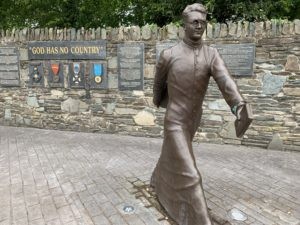 One was a priest. The other a pope. One was a modern-day saint. The other was a tale-as-old-as-time sinner.
One was a priest. The other a pope. One was a modern-day saint. The other was a tale-as-old-as-time sinner.
Recent travels have afforded me the opportunity to walk in the paths of both Monsignor Hugh O’Flaherty of Ireland and Pope Pius XII, born Eugenio Maria Giuseppe Giovanni Pacelli of Rome. Their paths converged at the Vatican during the atrocities of World War II. The subsequent passage of time has shown Pius XII to have been complicit in enabling Hitler’s genocide while appearing to say slightly reassuring things and O’Flaherty to have quietly done the right thing by saving 6,500 people from execution.
In Killarney, Ireland, O’Flaherty’s hometown, a sculpture honoring the swashbuckling priest was erected in 2013. I recently visited Killarney and was moved by the art, which shows the priest in full stride, a man on a mission. On a wall behind the sculpture are inscribed O’Flaherty’s own words: “God has no country.”
“We remember the priest today because of his self-sacrifice. We remember the pope today because of his self-protection.”
Somehow I had missed the movie where Gregory Peck played O’Flaherty and the BBC Radio drama about him and the one-man play about his life. His story was new to me, although well documented many places.
O’Flaherty has been called “Ireland’s Oskar Schindler” although in reality Schindler should be called the “German Hugh O’Flaherty” because the priest saved five times as many people as the German businessman. Both are heroes of history.
O’Flaherty understood the peril of the times in which he lived. He did not fool himself into thinking things weren’t really as bad as they appeared; he did not look away from the truth of detention camps and persecution based on ethnicity or country of origin.

Sculpture honoring Monsignor Hugh O’Flaherty in his hometown of Killarney, Ireland. (Photo by Mark Wingfield)
In the early years of the war, he toured prisoner of war camps in Italy and used Radio Vatican to reassure families their loved ones were alive. After Mussolini fell and Germany occupied Italy, prisoners who had been visited by O’Flaherty reached out to him for aid. With help from other priests and diplomats, he hid thousands of escapees, mainly Allied soldiers and Jews. He hid them in homes, apartments, convents and even in a house next door to the local SS headquarters.
The Nazis learned about O’Flaherty’s work and sought to assassinate him. They could not arrest him inside the Vatican (which became a sovereign state in 1922), so the local Gestapo head, Herbert Kappler, ordered a white line painted along the opening of St. Peter’s Square to indicate where occupied Rome began and protected Vatican soil ended. O’Flaherty knew he could not be caught even one step over that line.
Nevertheless, he traveled outside the Vatican, using an array of costumes and disguises, which gave him the nickname “The Pimpernel of the Vatican.” While on Vatican grounds, he often met his contacts in plain sight on the steps of St. Peter’s Basilica.
When the Allies liberated Rome in June 1944, they found 6,425 people alive under the protection of O’Flaherty’s network.
Elsewhere inside the Vatican, Pope Pius XII apparently had made a deal with the devil. Exactly what happened behind closed doors may never be known, although recent revelations from the Vatican archives are shedding horrible light on the pope. By the worst accounts, he made a deal with Hitler not to oppose him if Hitler would not bomb the Vatican – a sovereign country. By even the mildest revelations, the pope failed to oppose Hitler’s Final Solution and was himself driven by anti-Semitic beliefs.
“O’Flaherty . . . did not look away from the truth of detention camps and persecution based on ethnicity or country of origin.”
In a 2013 Vanity Fair article, Catholic writer John Cornwell explored all the evidence coming to light against Pius XII. He summarized:
“It gives a Catholic no satisfaction to accuse a pope of acquiescing in the plans of Hitler. But one of the saddest ironies of Pacelli’s papacy centers on the implications of his own pastoral self-image. At the beginning of a promotional film he commissioned about himself during the war, called The Angelic Pastor, the camera frequently focuses on the statue of the Good Shepherd in the Vatican gardens. The parable of the good shepherd tells of the pastor who so loves each of his sheep that he will do all, risk all, go to any pains, to save one member of his flock that is lost or in danger. To his everlasting shame, and to the shame of the Catholic Church, Pacelli disdained to recognize the Jews of Rome as members of his Roman flock, even though they had dwelled in the Eternal City since before the birth of Christ.”
The true example of the good shepherd in this case was O’Flaherty, who by the way was reportedly the only person to visit Kappler in prison after the war. We remember the priest today because of his self-sacrifice. We remember the pope today because of his self-protection.
We, too, live in perilous times that will define us for all time. How will history remember us? As protectors of ourselves and our institutions and our borders? Or as protectors of God’s children? As people who placed country over humanity? Or as people who truly believe O’Flaherty’s motto: “God has no country”?
As for me, I’d rather be remembered like Monsignor O’Flaherty than the ironically named Pope Pius.
